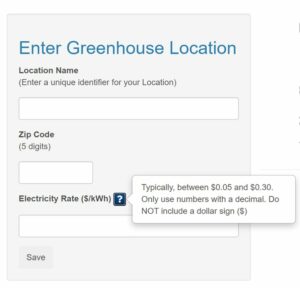A New Way to Determine Lighting Costs at Your Greenhouse
Supplemental lighting is often needed for ornamental or vegetable greenhouse production to complement sunlight during the darker months of the year. However, electricity costs for supplemental lighting can be high, and can be up to 30 % of the total operating costs.
Electricity costs can typically be reduced by using more efficient light fixtures, but often at the expense of higher capital costs. The tradeoff between capital and operating costs makes it difficult to decide which lighting system is most cost-effective.
Finding the optimal supplemental lighting system for a greenhouse is complicated. Growers should consider the recommended daily light integral (DLI; moles of photons per square meter per day) for a crop, the available solar radiation, light transmission into the greenhouse, and different supplemental lighting systems. Much information can be gained from trade journals, Extension articles, or manufacturer websites, but a critical piece of information is hard to get: the electricity costs of supplemental lighting based on the conditions in your greenhouse.
To estimate electricity costs associated with lighting, project LAMP (Lighting Approaches to Maximize Profits) developed an online electricity cost calculator for supplemental lighting in greenhouses. The calculator can estimate the lighting costs, using only a few simple inputs. The calculator is free and available on the Outreach page of the Hort Lamp website.
How to Use the Lighting Cost Calculator
To make the calculator as intuitive as possible, there are instructions about how to use it as you go from screen to screen. In addition, the FAQ tab gives users relevant information or definitions of the inputs for the calculator.
To start calculating lighting costs, users start on the Add Location tab, where the zip code of the greenhouse and electricity rate ($/kWh) are entered. Based on the zip code, the app retrieves historical sunlight data for that location, which is needed to calculate how much supplemental light is required.
On the Add Greenhouse Design tab, users enter the size of the greenhouse, the light transmission of the greenhouse, the target DLI, and the efficacy of the lighting system. On this page, users also can modify the percentage of the greenhouse area that will receive supplemental lighting each month of the year; for example, you can specify that no supplemental light will be used in the summer months or that only a part of the greenhouse will be lit at other times.
Once these inputs are saved, users go to the Electricity Costs tab, click Update, and the estimated lighting costs, based on the provided inputs, are displayed on a monthly and annual basis. Figure 1 illustrates how to provide the needed information, and Figure 2 shows the output from the calculator.

Figure 1

Figure 2
Like any online tool, the calculator has limitations. For example, the calculator assumes that enough supplemental lighting capacity is available to reach the target DLI even on the darkest day of the year, an unrealistic scenario. In addition, the calculator cannot account for edge effects, where some of the provided light spills out of the greenhouse. We are planning upgrades to improve functionality and appreciate suggestions.
Results From a Case Study
The app is designed to support decision-making, by allowing the simulation of different scenarios. In this example, supplemental lighting costs are calculated for two locations (Athens, GA, and Kalamazoo, MI) and three different lighting systems, representing HPS fixtures with an efficacy of 1.6 µmol/J, an average LED lighting system (2.5 µmol/J), and a very efficient LED lighting system (3.2 µmol/J).
We used an electricity cost of 0.12 $/kWh, a target DLI 17 mol/m2/d, 60% greenhouse transmission, and a 10,000 square-foot greenhouse. Lighting costs in Kalamazoo, MI, are almost twice as high as in Athens, GA, because of the short days and low sunlight levels in Michigan in winter. The annual lighting costs also depend on the efficacy of the supplemental lights, because a higher efficacy lowers the electricity requirements and costs. The results suggest that a greenhouse in the upper Midwest will benefit more from replacing HPS fixtures with more efficient LED fixtures than a greenhouse in the south, because more supplemental light is needed further north.
In addition to estimating cost savings that can be achieved with a more efficient lighting system, the calculator also can estimate the effect of different greenhouse glazing materials (which affect light transmission) on the electricity costs associated with supplemental lighting.
Our hope is that this tool will help growers make better-informed decisions related to the pros and cons of different lighting systems or glazing materials. Users can simulate as many scenarios as they like. If desired, inputs and results can be downloaded and further analyzed in a spreadsheet. If you have questions or suggestions, please let us know by sending a message to [email protected].
This calculator was developed in collaboration with students and faculty in the Department of Information Systems at the University of Georgia, as part of the USDA Specialty Crops Research Initiative-funded Project Lamp.










